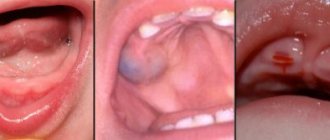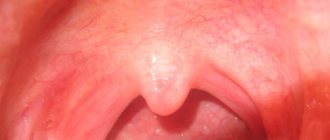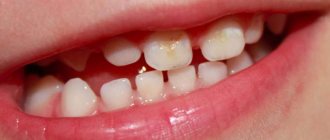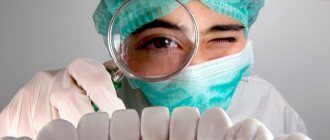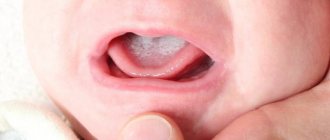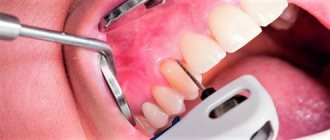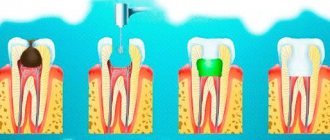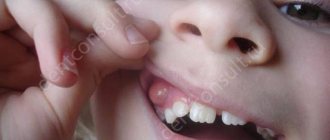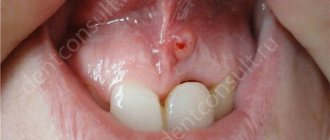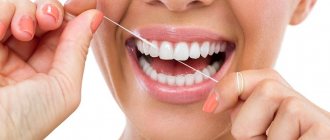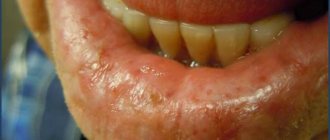Periodontitis in children: a mouth full of worries
Periodontitis is a disease in which all periodontal tissues become inflamed. Inflammation of the gums occurs, destruction of muscle ligaments, pathological periodontal (so-called periodontal) pockets are formed, the process affects the bone, then teeth begin to loosen and fall out.
Periodontitis in children is most often detected at the age of 9 - 10 years. And although this is not the most common dental disease, it occurs in only 3 - 5% of children, nothing guarantees that your child will not be affected by this problem.
The peculiarity of the course of periodontitis in children is that the inflammatory process affects functionally immature, growing, constantly remodeling tissues, which sometimes react inadequately even to minor damage.
In addition to the standard division according to prevalence into local and generalized, as well as into chronic and acute - according to the nature of its course, childhood periodontitis is divided into prepubertal and pubertal.
Causes of periodontitis in children
In most cases, childhood periodontitis occurs due to insufficient dental hygiene. At the same time, natural factors also have an influence: 9 years is the “borderline” age when children begin to develop permanent teeth instead of baby teeth. During this period, the risk of gum damage increases, and with it the risk of complications increases.
In adolescents, due to changes in hormonal levels, the destruction of periodontal tissue manifests itself in a more acute form and is accompanied by bad breath and purulent discharge from periodontal pockets.
In some cases, the cause of the disease is genetic abnormalities (when parents are carriers of specific microorganisms).
Prepubertal periodontitis
It begins during the eruption of baby teeth or immediately upon its completion. It is characterized by disruption of the connection between the gum and tooth and serious destruction (change in structure) of the bone. Prepubertal periodontitis already at a very early age leads to the loss of a large number of baby teeth, after which the inflammatory process spreads to the rudiments of permanent teeth. The causes of the development of prepubertal periodontitis are most often weakened immunity, as well as the presence in the child’s oral cavity of specific types of microorganisms, the original carriers of which in most cases are the baby’s parents.
Inflammatory periodontal diseases in children
Part I. Clinic, differential diagnosis of inflammatory periodontal diseases
The periodontium unites a complex of tissues that surround the tooth and have genetic and functional commonality: periodontium, alveolar bone, gums, tooth root cement. This complex of tissues ensures reliable fixation of the tooth in the jaw bones.
Periodontal diseases in children are widespread. According to WHO, 80% of children have some form of periodontal disease. They can be inflammatory, dystrophic and tumoral in nature. The largest group of periodontal diseases are inflammatory (gingivitis, periodontitis). They account for 94-96% of all periodontal diseases. Gingivitis (catarrhal or hypertrophic, edematous form) and periodontitis have the same causative factor. These are two interrelated forms of the disease. With gingivitis, the inflammatory process is limited only to the gums. The spread of inflammation to other periodontal tissues (periodontium, root cementum, alveolar bone) leads to the development of periodontitis. The prevalence of gingivitis in childhood is 80%, periodontitis - 3-5%. Most often, periodontal diseases are detected at the age of 9-10 years.
Gingivitis and periodontitis are divided into:
- according to the clinical course: acute, chronic, aggravated;
- by localization: localized, generalized;
- by severity: initial, mild, moderate, severe.
Depending on the age of the child, periodontitis is divided into:
- for prepubertal periodontitis - up to 11-12 years;
- puberty (juvenile) - from 12 to 17 years;
- post-pubertal - from 17 to 21 years.
Features of the development of periodontal diseases in
children are associated with the fact that, firstly, the pathological process develops in the growing, constantly remodeling tissues that make up the periodontium, in tissues that are morphologically and functionally immature, capable of reacting inadequately even to minor damaging factors. On the other hand, periodontal pathology can develop against the background of disproportion in the growth and maturation of tissue structures both within a system that has common functions (tooth, periodontium, alveolar bone, etc.), and in structures and systems that provide the entire body and adapt it to changes in the external environment (nervous, humoral, endocrine, etc.), which causes the occurrence of periodontal diseases in the juvenile period. In addition, the condition of the periodontium may be influenced by the lack of synchrony between the rate of eruption of permanent teeth and the rate of construction of the alveolar bone, which leads to a decrease in the zone of attached (alveolar) gum, lengthening of the clinical crown of the teeth by 2-5 mm, and a decrease in the depth of the vestibule. Therefore, when assessing the clinical and radiological signs of periodontal diseases, it is necessary to take into account the structural features of the periodontium in childhood. The gingival groove in children is deeper, up to 3 mm, and during tooth eruption up to 4 mm; the periodontal gap in the cervical region during the period of incomplete root formation is 2 times wider than in adults, which must be taken into account when analyzing radiographs; mineralization of the tips of the interalveolar septa and the compact plate is completed simultaneously with the end of root formation, that is, in the frontal area at the age of 8-9 years, and in the lateral areas at 14-15 years.
Etiological factors
Inflammatory periodontal diseases are divided into local and general. This division is conditional, since etiological factors can be closely related to each other and to the child’s body. Both local and general factors have different effects on immature periodontal tissues in childhood.
According to WHO, the leading role in the development of periodontal diseases belongs to the microflora of dental plaque, dental plaque, which is represented mainly by gram-negative and gram-positive cocci, obligate and facultative anaerobes, actinomycetes, protozoa, fusobacteria, yeast fungi, spirilla, spirochetes, bacteroides, etc.
The formation of dental plaque in large quantities is observed, on the one hand, with poor oral hygiene or lack thereof. On the other hand, the formation of abundant plaque and dental plaque is associated with a violation of the mechanisms of natural self-cleaning, which can be caused by a number of factors that occur in the child’s oral cavity:
- hyposalivation or viscous saliva;
- traumatic occlusion, which is observed with crowding of teeth, malocclusion in different planes, improperly performed orthodontic treatment, early removal of primary molars, which leads to overload of permanent incisors;
- anomalies in the structure and attachment of the frenulum of the lips and tongue, small vestibule of the oral cavity;
- dysfunction of chewing (lazy or chewing on one side), swallowing (infantile type), breathing (oral, mixed type);
- bad habits;
- chronic periodontal trauma from decayed teeth, incorrectly applied fillings, parts of orthodontic appliances, self-inflicted periodontal injuries by adolescents with nails, pens, hairpins, etc.;
- insufficient load on the masticatory apparatus associated with the predominance of carefully processed soft foods in the diet.
All of the above factors make it difficult to wash out microbes with saliva, which leads to an increase in the number of pathogenic microorganisms in the oral cavity and disruption of the dynamic balance between normal and pathogenic flora of the oral cavity. Self-cleaning is understood as the constant ability of the oral cavity to cleanse its organs of detritus, food debris, and microflora. The main role in this is played by the salivary glands, which provide an adequate volume of secretion, flow and quality of saliva necessary for the formation of a food bolus that is convenient for chewing and swallowing. The movements of the lower jaw, tongue, lips, cheeks, as well as the normal structure of the dental system, the correct functioning of the functions of chewing, swallowing, breathing, speech, the full load of the masticatory apparatus, the nature of nutrition (the predominance of coarse, hard food) are important. The dental pulp also takes part in self-cleaning due to the release of dental cerebrospinal fluid onto the tooth surface. It is known that teeth that are pulpless and located outside the dental arch are difficult to clean. Through the pulp, its vascular network, and connective tissue structures, the influence of the general condition of the child’s body on the ability of the tooth surface to self-clean is realized.
Until the 60s of the 20th century, the development of inflammatory periodontal diseases was associated, on the one hand, with systemic diseases of the body (however, the mechanism of changes in the periodontium was not clear), and on the other, with occlusal trauma. But overloading of the teeth leads to destructive processes in the periodontal bone tissue, and not to inflammation, and it does not occur in all patients. And only since the 60-70s of the last century, dentists began to associate periodontal diseases with dental plaque.
It has been clinically and experimentally established: without dental plaque there is no periodontitis
.
All causative factors were divided into primary and secondary. The primary set of causes included dental plaque and the inflammatory reactions caused by it. The secondary complex of causes covered local and systemic factors that allowed the primary complex to be realized. At the same time, inflammatory periodontal diseases were considered as a consequence of nonspecific infection of the periodontium by microbes of dental plaque and dental plaque. And since the late 80s of the last century, the hypothesis about the existence of a specific microflora of dental plaque has come to the fore. New microorganisms from the bacteroid group were discovered: Actinobacylus actinomycetemcomintans, Prevotellaitermedia, Porphyromonas gingivalis, Bacteroidesmelanogenicus
, etc. The existence of periodontopathogenic bacteria was recognized. If in a healthy periodontium gram-positive aerobic microorganisms predominate, and the proportion of gram-negative microorganisms is 10-15%, then with periodontitis this ratio becomes the opposite.
Currently, inflammatory periodontal diseases are considered as an opportunistic infection that adapts to existence in the oral cavity and displaces other, less pathogenic microorganisms. This infection depends not only on the presence of pathogenic specific bacteria, but also on the environment conducive to their reproduction - local changes in pH, anaerobic niche (gingival grooves, pockets), as well as changes in the body's resistance.
The basis of pathogenesis
Inflammatory periodontal diseases (gingivitis, periodontitis) are a response to an immunologically determined inflammatory reaction in periodontal tissues under the influence of specific microflora. The reaction involves systems of nonspecific and specific immunity (cellular and humoral immunity), inflammatory mediators.
The resulting inflammatory mediators (histamine, serotonin, bradykinin) increase vascular permeability, cause hyperemia, swelling of the gums, periodontium, alveolar bone, as well as gum pain. Initially, symptoms of gingivitis appear (catarrhal or hypertrophic, edematous form). During its long-term course in the absence of treatment, loosening and destruction of the periodontal epithelial attachment occurs, germination of the epithelium in the apical direction with subsequent bone resorption, due to both the cytotoxic effect of microbial endotoxins and an acidic environment, and the activation of osteoclastic resorption under the influence of inflammatory mediators (lymphokines, leukotrienes, interleukins, prostaglandin E2). Systemic diseases (endocrine, diseases of the cardiovascular system, blood, gastrointestinal tract, hypovitaminosis, dysfunction of the gonads, immunodeficiency states, etc.) lead to changes in the immunobiological reactivity of the body, to a decrease in protective and adaptive reactions that ensure the resistance of the body in general and periodontal disease in particular. There are numerous studies that indicate a significant weakening of nonspecific and specific immunity factors in patients with periodontitis. In this regard, conditions are created for the implementation of the primary set of causal factors. Differences in the course of periodontal diseases are determined by the different state of immunity in patients. Prolonged contact of the labial plaque microflora with periodontal tissues can lead to the development of autoimmune processes.
Local factors
Insufficient level of oral hygiene
The inability to properly brush your teeth with a special children's toothbrush and the reluctance to regularly carry out hygiene procedures lead to the accumulation of microorganisms in the periodontal pockets, and the toxins they release trigger the inflammatory process.
Short frenulum of the tongue or lip
Insufficiently long frenulums provoke atrophy and inflammation of the adjacent gum area due to constant tension on the frenulum fibers. The inflammatory process is localized in the area of the lower central teeth.
Chewing food on one side
The habit of chewing food on one side is fraught with the accumulation of plaque on teeth that are not involved in chewing. It is necessary to explain to the child that food should be chewed on both the left and right sides.
Anomalies and deformations of the dental system
The development of the inflammatory process in periodontal tissues can be caused by both functional overload of certain teeth and insufficient load on them. The reason for this is an incorrect bite or an incomplete set of teeth (the permanent teeth have not yet grown in, and some of the baby teeth have already fallen out).
Gum injuries
This group of factors that provoke the occurrence and development of periodontitis includes chronic trauma to the gums from decayed teeth or parts of braces, as well as filling defects and damage to periodontal tissue by nails, pens, and hair clips.
Nutritional nature
Too soft food does not contribute to a sufficient load on the child’s chewing apparatus and self-cleaning of the teeth, which results in the accumulation of plaque at their base, and as a result, the appearance of tartar in children.
Why is the problem developing?
Experts have been paying close attention to the study of pathological processes in the oral cavity occurring in childhood for a long time. This made it possible to fully study the causes of the development of existing periodontal diseases. The main one in this group is called microbial plaque, infested with pathogenic bacteria. Parents, in turn, do not respond at all to requests from pediatric dentists to seek help when plaque is detected on the child’s teeth, especially if they are unable to remove it on their own.
Photo: Plaque on teeth
The low resistance of the child’s body to all kinds of external irritants is a factor that obviously aggravates the course of periodontal pathologies.
It is worth considering that factors that influence the development of periodontal diseases at a tender age are divided into local and general. Locals include:
- insufficient oral hygiene;
- dystopia of the dentition;
- too close arrangement of teeth relative to each other;
- frequent consumption of exclusively soft food by the child;
- the habit of unilateral chewing;
- decreased saliva secretion;
- too high viscosity of saliva;
- chemical trauma to the oral cavity or its mechanical damage;
- insufficient vestibule of the oral cavity.
Photo: Dystopia of the canine
Doctors tend to include constant exposure to traumatic factors, including overhanging edges of fillings, in this group.
The group of common factors that aggravate the course of the inflammatory process includes:
- endocrine pathologies;
- hypovitaminosis;
- violation of metabolic processes;
- rheumatism;
- nervous diseases.
Treatment of periodontitis in children: the work of professionals
Non-surgical methods for treating the inflammatory process of periodontal tissue are the same as in adults.
This includes professional oral hygiene and various physiotherapeutic procedures. Surgical interventions, such as lip frenulum correction, may also be required. In any case, before prescribing certain procedures, a child must visit pediatric dentistry for consultation with three specialists - a therapist, a surgeon and an orthodontist. They will determine the true causes of periodontitis and develop an individual treatment plan. It is also important to exclude systemic diseases that can provoke periodontitis. Their treatment must be carried out with the participation of a specialist of the appropriate profile.
Treatment of periodontitis during pregnancy
Periodontitis refers to inflammatory diseases of the periodontal tissues (surrounding the tooth). The cause of this disease is often untreated gingivitis, as well as insufficient oral hygiene. All this can be aggravated by hormonal changes during pregnancy, which is an additional provoking factor.
Let's take a closer look at the symptoms that accompany periodontitis in pregnant women.
- Inflammation of the gum edge, as well as the periodontal papillae, which is expressed in their redness (or cyanosis) and swelling.
- Bleeding gums when brushing teeth.
- The presence of dental plaque, which can be either soft or hard in the form of tartar. In the latter case, hard deposits can be supra- and subgingival.
- Destruction of bone tissue. With mild periodontitis, the bone atrophies by approximately 1/3 of the root length. More pronounced atrophic processes (with bone destruction by 2/3 or more) occur in severe forms of periodontitis.
- When examined by a doctor, the formation of periodontal pockets is detected, the depth of which can vary. Due to the formation of such pockets, the connection between teeth and gums deteriorates.
- Tooth mobility increases; this symptom is most pronounced in severe periodontitis.
- Bad breath appears due to the accumulation of serous-purulent exudate in periodontal pockets.
Treatment of periodontitis during pregnancy consists primarily of removing dental plaque. It is best to carry out this procedure in the second trimester of pregnancy. At the same time, the doctor prescribes anti-inflammatory therapy, which consists of performing antiseptic applications and rinses. This treatment is carried out in a course after removing dental plaque.
Metrogil-denta gel and Cholisal can be used as applications to the gums. For rinses, your doctor may recommend non-alcoholic herbal solutions, fluoride rinses, and Chlorhexidine solution.
Part of the treatment of periodontitis is the use of anti-inflammatory pastes with a high content of medicinal herbal extracts. In this case, more attention must be paid to oral hygiene, using dental floss and an irrigator for thorough cleaning.
